History of Gokayama Washi
In the feudal period, Gokayama was the domain of the Lord Kaga, of which a lot of old documents related to Gokayama Washi remain. There are few production areas nationwide where the primitive wooden tools such as papermaking boats and takuri boats for peeling the barks, ash boxes for boiling are existed except Gokayama. It is considered that the technique of washi making conveyed directly from Nara and Kyoto was formed by this mountain people into unique washi culture.
The records shows that Gokayama Washi had been paid as an annual tribute to the Lord Kaga in addition to raw silk since1585. In the Edo period, Gokayama Washi developed under the protection of the Kaga clan along with ensho or gunpowder ingredient. People in Gokayama raised silkworms to manufacture raw silk through spring to autumn, produced gunpowder ingredient in summer and made washi paper in winter living in a large triangle shaped thatched house called “Gassho-zukuri”.
In 1950, the Goka Paper Cooperative was organized in order to preserve Gokayama Washi in later years, and in 1968 the Higashi-Nakae Washi Production Association was formed. While the production area of Washi disappeared one after another nationwide, Gokayama washi has been protecting the traditional techniques and passed down the classical washi paper making.
In 1982, as the demand for washi decreased due to the spread of western paper, the Washi Craft Research Center, the predecessor of Washi no Sato was established in order to create new products and train successors to washi. In 1988, Gokayama Washi was designated as a national traditional craft under the name of "Etchu Washi" along with two other washi production sites of Yatsuo and Asahi located in the same prefecture of Toyama (its ancient name Etchu). Its long history and tradition cultivated by the abundant nature of mountain village was evaluated as a Washi Culture.
Today Gokayama Washi is used for shoji screen paper of the Katsura Imperial Palace and restoring paper for documents of the Imperial Household Agency and National Important Cultural Properties. Gokayama washi has also become custom-made items from artists such as chigirie or paper collage, woodblock prints, paintings and materials for various arts and crafts as well as interior finishing.
The records shows that Gokayama Washi had been paid as an annual tribute to the Lord Kaga in addition to raw silk since1585. In the Edo period, Gokayama Washi developed under the protection of the Kaga clan along with ensho or gunpowder ingredient. People in Gokayama raised silkworms to manufacture raw silk through spring to autumn, produced gunpowder ingredient in summer and made washi paper in winter living in a large triangle shaped thatched house called “Gassho-zukuri”.
In 1950, the Goka Paper Cooperative was organized in order to preserve Gokayama Washi in later years, and in 1968 the Higashi-Nakae Washi Production Association was formed. While the production area of Washi disappeared one after another nationwide, Gokayama washi has been protecting the traditional techniques and passed down the classical washi paper making.
In 1982, as the demand for washi decreased due to the spread of western paper, the Washi Craft Research Center, the predecessor of Washi no Sato was established in order to create new products and train successors to washi. In 1988, Gokayama Washi was designated as a national traditional craft under the name of "Etchu Washi" along with two other washi production sites of Yatsuo and Asahi located in the same prefecture of Toyama (its ancient name Etchu). Its long history and tradition cultivated by the abundant nature of mountain village was evaluated as a Washi Culture.
Today Gokayama Washi is used for shoji screen paper of the Katsura Imperial Palace and restoring paper for documents of the Imperial Household Agency and National Important Cultural Properties. Gokayama washi has also become custom-made items from artists such as chigirie or paper collage, woodblock prints, paintings and materials for various arts and crafts as well as interior finishing.
How Gokayama Washi is Made.
Gokayama Washi-no-Sato is engaged in everything from the cultivation of the raw materials to the processing of washi paper. We carefully raise our own kozo, a type of paper mulberry on a field about a hectare in size where is blessed with abundant snow melting water. Its strong fiber natured by nature creates Gokayama Washi reputed for its durability.
-
1
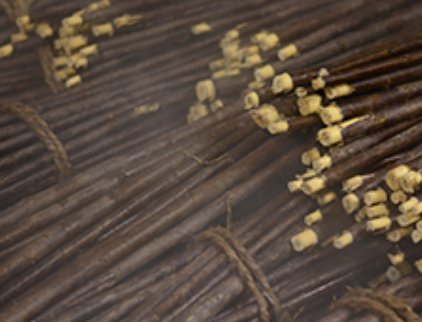
Steaming of Kozo, Paper Mulberry Tree (around Dec.)
The kozo stalk is steamed for two to three hours, which makes it easier to strip the bark. -
2
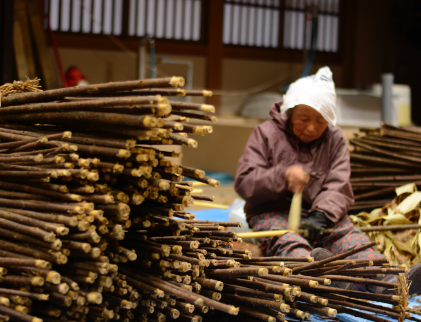
Stripping the bark (around Dec.)
The bark is removed from the steamed stalk by hand and dried. The stripped bark is called “kurokawa” or black bark. -
3
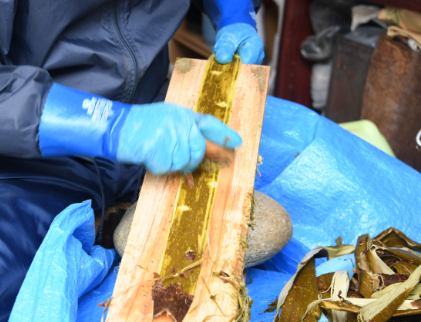
Scraping the dark bark (early Jan.)
After soaked in water and softened, the dark bark is scraped with a knife to remove its dark outer skin and damaged areas, leaving white inner layer called “shirokawa” or white bark. -
4
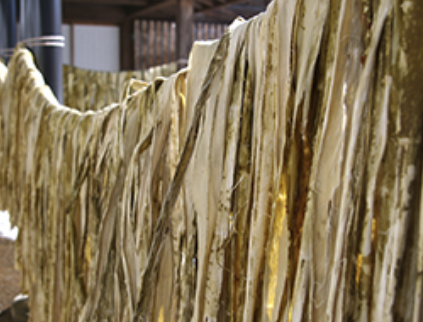
Drying the white bark (early Jan. to Mar.)
The white bark is completely dried and stored for further processing. -
5
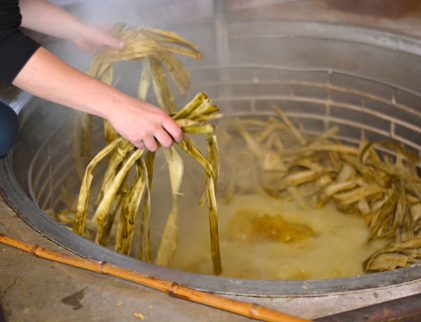
Boiling the white bark
The dried white bark is soaked in water overnight and then boiled in a large pot for two to three hours. -
6

Rinsing the white bark
The boiled bark is rinsed in running water to get rid of the harshness. -
7
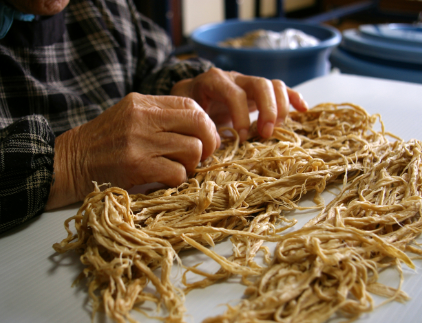
Checking the white bark
The bark is carefully examined and the flaws and flakes on the bark are removed by hand. -
8
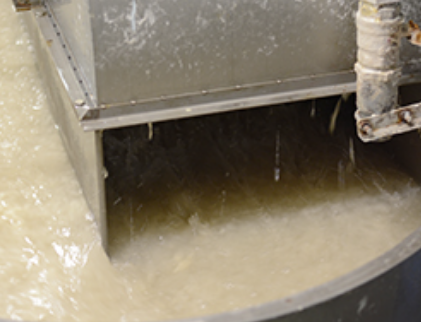
Breaking down the white bark
The bark is pounded on a stone surface to loosen its fiber and then broken into fine fiber by machine. -
9
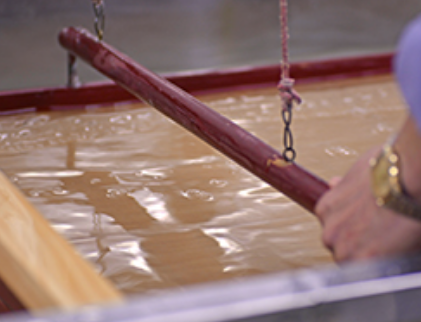
Paper making
“Sukibune” vat is filled with water, in which the beaten fiber and glue called neri are added to be mixed well. The pulp mixture is scooped with a tool called “Suketa” made of a wooden mold and a bamboo screen. The mold is gently moved to drain away the excess water. By repeating the scooping and shaking a few times, a single sheet is formed. -
10

Pressing the sheets
A stack of sheets is leaved overnight to drain naturally. Then it is pressed with weight until more moisture is removed. -
11
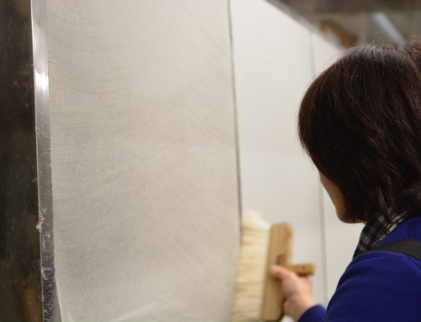
Drying the sheets
Each sheet is carefully removed from the stack and brushed on to a steam heated steel surface for drying. -
12
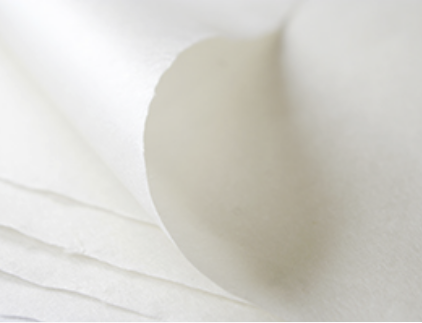
Final Inspection
Each sheet is inspected, weighed and then sorted. The Gokayama Washi is complete.
Workshop Menu
-
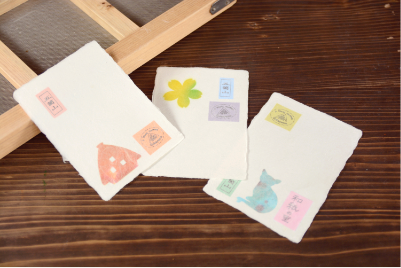
Post Card
Time : about 20min.
Charge : 800 JPY / person
Open : 10:00〜15:00
Road station TAIRA Gokayama Washi no Sato
-
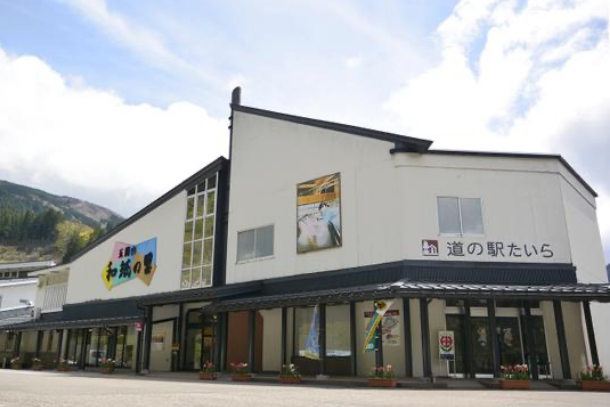 215 Higashi Nakae, Nanto-shi, Toyama
215 Higashi Nakae, Nanto-shi, Toyama
Phone: 0763-66-2223
Fax:0763-66-2250
Mail: info@gokayama-washinosato.com
The maps and brochures of Gokayama and nearby areas are available. Please take opportunities here to have a break and relax. The videos in English & Japanese such as washi Japanese paper making process and local dances and songs are offered to show.









